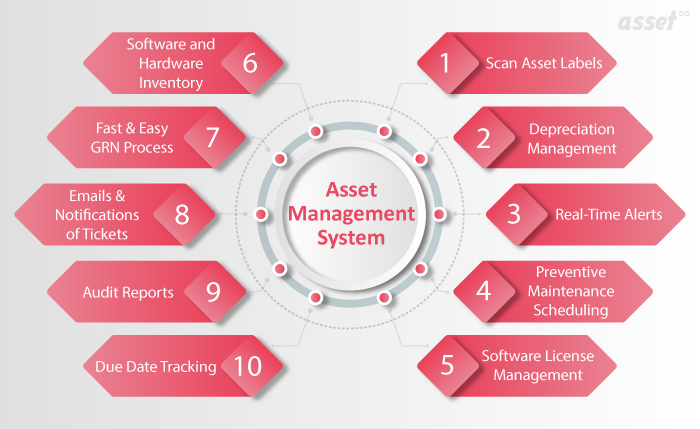The Distinction Between Asset Management and an Asset Management System
Asset management is a critical practice for organizations across various industries, enabling them to effectively manage their valuable resources. However, it’s essential to differentiate between “asset management” and an “asset management system,” as they represent distinct concepts that contribute to the overall success of an organization.

Asset Management: Asset management refers to the strategic and comprehensive approach of planning, acquiring, operating, maintaining, upgrading, and disposing of assets in a manner that aligns with an organization’s objectives and maximizes value. Assets can include physical assets like infrastructure, equipment, and facilities, as well as intangible assets like intellectual property and data. Asset management encompasses a wide range of activities, including asset inventory, risk assessment, lifecycle analysis, and performance optimization.
The primary goal of asset management is to ensure that assets are utilized efficiently, meet regulatory requirements, and contribute to the organization’s financial and operational objectives. It involves decision-making processes that balance cost, risk, and performance to achieve the best possible outcomes over the lifecycle of the assets.
Asset Management System: An asset management system, on the other hand, is a structured framework or software solution that facilitates the implementation and execution of asset management practices. It provides a systematic approach to organizing, analyzing, and leveraging data related to assets. An asset management system integrates processes, people, technology, and data to enhance decision-making, increase efficiency, and promote consistency in asset management activities.
Asset management systems often include features such as asset tracking, maintenance scheduling, performance monitoring, and reporting. These systems enable organizations to centralize asset-related information, streamline workflows, and generate insights for informed decision-making. They serve as a tool to implement asset management strategies effectively.
Key Differences: The primary distinction between asset management and an asset management system lies in their scope and nature. Asset management is a strategic practice that encompasses a holistic approach to managing assets throughout their lifecycle. It involves defining organizational goals, strategies, and policies related to asset utilization and optimization.
On the other hand, an asset management system is a technical tool that supports the execution of asset management practices. It provides a platform for collecting, analyzing, and managing asset data, enabling organizations to implement their asset management strategies more efficiently.
In conclusion, asset management and an asset management system are interconnected concepts that work together to enhance an organization’s overall asset management approach. While asset management focuses on strategic decision-making and maximizing value, an asset management system serves as a practical tool to implement and streamline asset management practices.
Navigating the Differences Between Asset Management and an Asset Management System
The world of modern business places great importance on the effective management of assets, both tangible and intangible. However, it’s crucial to distinguish between the broader concept of “asset management” and the specific tool known as an “asset management system.” By understanding their differences, organizations can harness their power to achieve greater efficiency and strategic success.
Asset Management: At its core, asset management encompasses the strategic processes and practices involved in overseeing an organization’s assets. These assets can be physical, such as equipment, buildings, and vehicles, or intangible, such as patents, trademarks, and intellectual property. Asset management involves activities ranging from acquisition and maintenance to depreciation and disposal.
The ultimate aim of asset management is to optimize the value, performance, and utilization of assets while mitigating risks and adhering to regulatory compliance. It involves making informed decisions based on factors like asset lifecycles, maintenance schedules, and financial considerations.
Asset Management System: An asset management system, on the other hand, is a technological tool or software that facilitates the implementation and execution of asset management practices. It acts as a centralized platform for organizing, tracking, and analyzing asset-related data. Such systems provide functionalities like inventory management, maintenance scheduling, and performance monitoring.
Asset management systems enable organizations to streamline their asset-related workflows, reduce manual errors, and enhance data-driven decision-making. They serve as repositories of crucial information, helping organizations optimize asset utilization and minimize downtime.
Key Differences: The primary distinction lies in their scope and focus. Asset management is a strategic and holistic approach that encompasses various activities to ensure assets contribute to an organization’s objectives. It involves decision-making at a high level, aligning assets with business goals and fostering long-term success.
On the other hand, an asset management system is a tool that supports the operational execution of asset management practices. It assists in tracking asset details, monitoring maintenance schedules, and generating reports. While an asset management system enhances the efficiency of asset-related tasks, it operates within the broader framework of asset management.
In conclusion, asset management and an asset management system are two interconnected elements that contribute to effective asset management. While asset management involves strategic decision-making and holistic optimization, an asset management system is a technological tool that facilitates the implementation of asset management practices, helping organizations achieve their strategic objectives.

Enhancing Efficiency and Strategy: Navigating the Difference Between Asset Management and an Asset Management System
In the landscape of modern business operations, managing assets has emerged as a pivotal aspect of organizational success. However, to fully grasp the intricacies of asset management, it’s essential to distinguish between the broader concept of “asset management” and the specialized tool known as an “asset management system.” By understanding their unique roles, organizations can harness their combined potential to elevate efficiency and strategic decision-making.
Asset Management: At its essence, asset management embodies the strategic and comprehensive approach to overseeing an organization’s assets throughout their lifecycle. These assets encompass physical entities like equipment, machinery, and facilities, as well as intangible assets such as patents, copyrights, and data. Asset management entails a spectrum of activities, from procurement and maintenance to depreciation and eventual disposal.
The core goal of asset management is to optimize the value, performance, and utility of assets while minimizing risks and ensuring regulatory compliance. This practice involves making informed decisions guided by factors like asset lifecycles, maintenance needs, and financial considerations.
Asset Management System: Conversely, an asset management system constitutes a specialized software tool or framework that facilitates the implementation and execution of asset management strategies. It serves as a centralized repository for organizing, tracking, and analyzing data pertaining to assets. These systems offer functionalities ranging from asset tracking and maintenance scheduling to performance monitoring and reporting.
The role of an asset management system is to streamline asset-related workflows, reduce manual errors, and enhance data-driven decision-making. By consolidating vital information, these systems empower organizations to optimize asset utilization and minimize disruptions caused by inadequate maintenance or untimely replacements.
Key Differences: The primary distinction between the two lies in their scope and focus. Asset management entails a strategic and all-encompassing approach that spans the lifecycle of assets. It involves high-level decision-making that aligns assets with overarching business objectives, considering factors such as operational efficiency, regulatory compliance, and financial viability.
On the other hand, an asset management system is a tactical tool that supports the operational execution of asset management practices. It aids in the organization and retrieval of asset-specific details, facilitates maintenance planning, and generates actionable insights from data. While an asset management system enhances the efficiency of asset-related tasks, it operates within the broader framework of asset management.
In conclusion, asset management and an asset management system complement each other in enhancing organizational efficiency and strategic decision-making. Asset management involves high-level planning and optimization, while an asset management system provides the practical means to implement and execute those strategies, ultimately contributing to the overall success of an organization.
